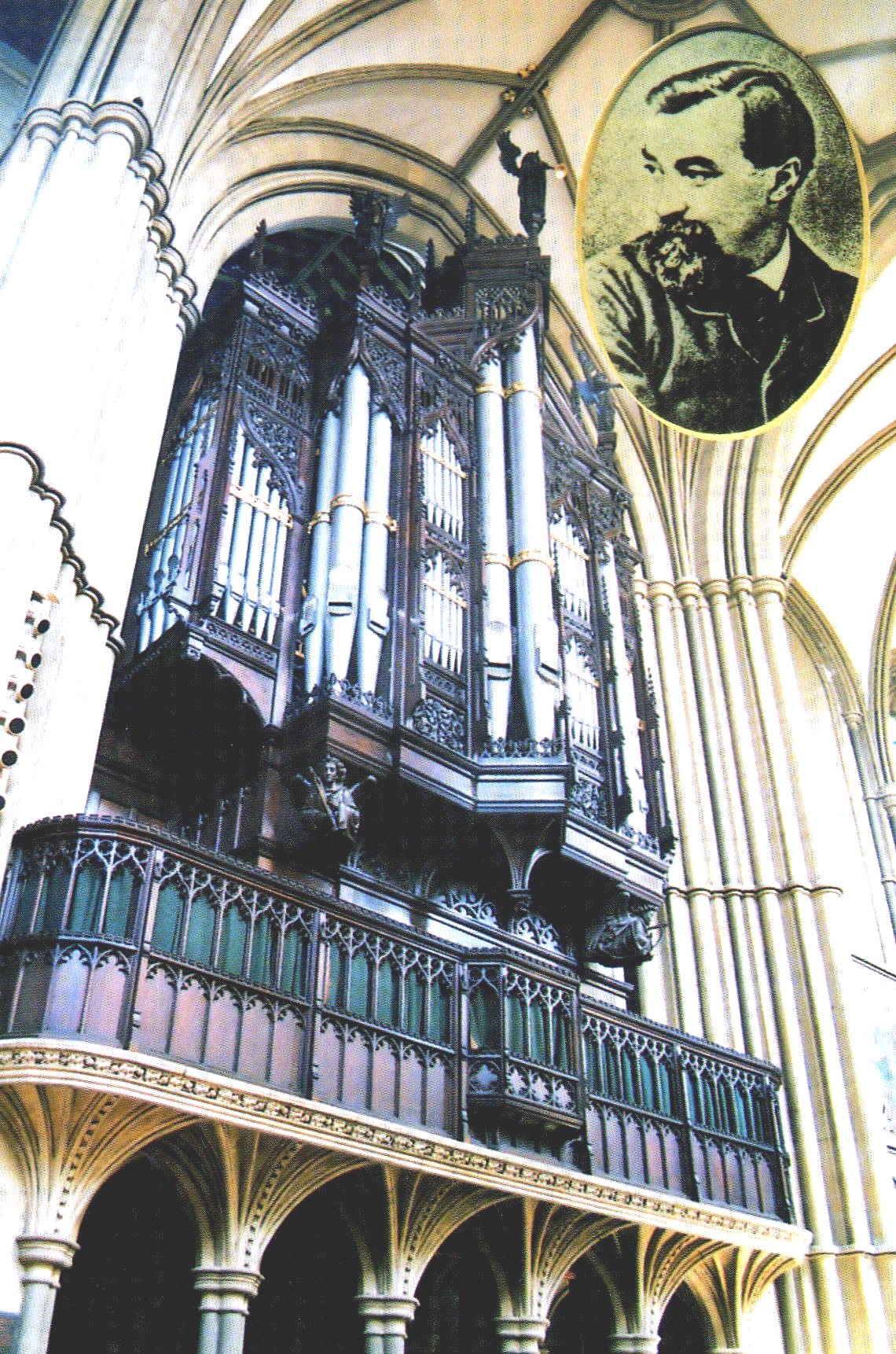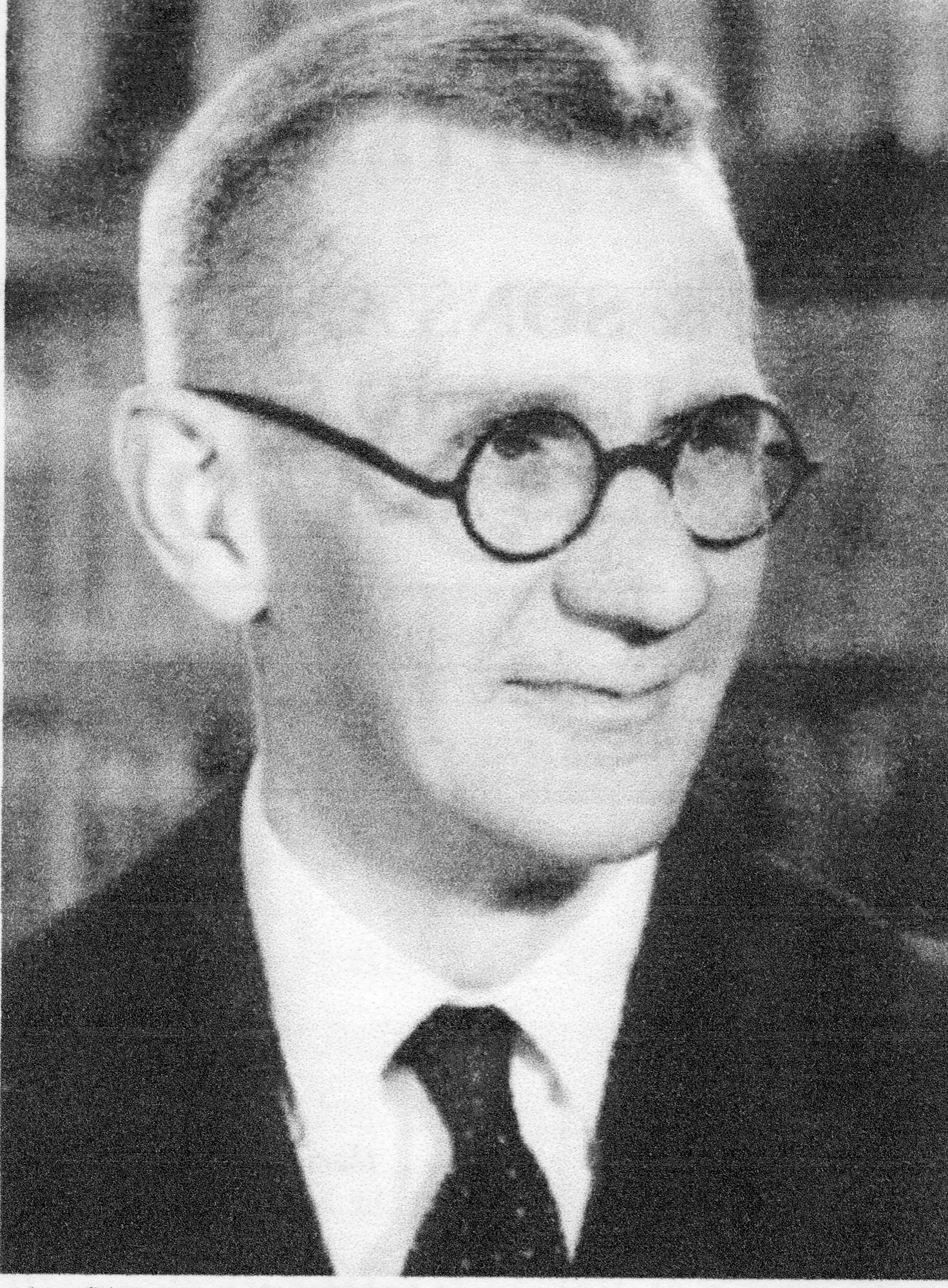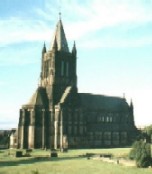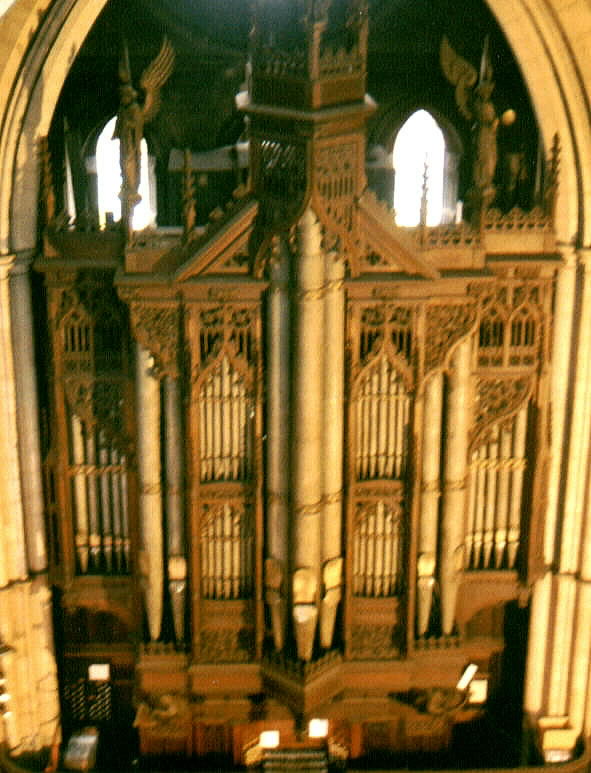|

|
|
By
Kenneth
I. Johnstone
Ph.D MB CH. ARPS
Foreword
by
Ralph Downes C.B.E.
First
Edition 1978
Second
Edition 1985
This book is written to preserve the
fascinating story of the world-famous
Schulze organ –
a story of genious, romance and tragedy – in the
hopefully
that it may touch the heart of some generous
benefactor and so save this
priceless treasure for the
inspiration and enjoyment of future generations.
In
1990 news of a generous bequest for the restoration of the
Organ was received;
the story continues in the -
Third
Edition 2021
Contributions from:
Graham Barber
BA M.Mus., FRCO, Mike Collins,
Thelma Collins, Chris
Newton, Mark Venning - Harrison & Harrison
Photo
Plates: Keith Johnstone
Photos: Archives, Mike Collins,
Rob Shorland-Ball
Editorial
Team: Thelma Collins, Arnold Mahon, Rob Shorland-Ball
|
CONTENTS
|
Introduction
& Prelude, Fugue and Coda
Foreword
Preface,
Acknowledgements & Preface 2nd
edition
Preface to the present edition on-line
|
Arnold
Mahon, Rob Shorland-Ball
Ralph Downes
Kenneth
Johnstone
Thelma Collins
|
|
I
II
III
IV
& V
VIa
VIb
VII
VIII
IX
10
11
12
13
14
|
Fugue
— Kenneth Johnstone
J. F. Schulze & Sons and
the visit of Allbutt and Kennedy to Paulinzelle
The growth
of the Organ specification
Edmund Schulze and the
Organ at Meanwood Towers
Removal
of the Organ to St. Peter's Church, Harrogate
Presentation
of the Organ to St. Bartholomew's Church, Armley, Leeds
The
Organ at Armley from 1879 to the rebuild by J J Binns in 1905,
with a detailed specification
The maintenance of the
Organ from 1905 to 1974 and its influence on the music at
Armley
The
Organ Appeal of 1974: the first stage of the restoration
and the Centenary of the Organ at Armley in 1979
An
appreciation of the Organ as it was in 1985
Fugue
— various contributors
Restoration Fund-raising
Gathers Pace: The Gala Concert Souvenir Brochure of
1990.
Contributions by: Chris Newton, Graham Barber, Mike
Collins, and Kenneth Johnstone's Obituary.
Fund-raising
gathers Pace
The Appeal: 1996-2000 -- Thelma Collins
Coda
- various contributors
The Organ Restoration,
2000-2004 — Mark Venning (MD Harrison & Harrison),
Mike Collins,
Graham Barber; Father Timothy Lipscomb
(Vicar of St Bartholomew's)
And Now ..... .. Thelma
Collins (Assistant Organist since 1975)
and Organists of
St. Bartholomew's Church 1878 to the present
|
PRELUDE,
FUGUE & CODA
The
following edited extracts from two former Organists' descriptions
of the Organ are a useful starting point for what follows in our
Prelude:
The
conception for this world-famous instrument came from a Meanwood
(Leeds) man, Thomas Stuart Kennedy, who was a partner in the
engineering firm of Fairbairn, Kennedy and Naylor. Both Mr.
Kennedy and his wife were enthusiastic amateur musicians and Mrs.
Kennedy was a performer on both piano and organ. In 1866 Kennedy
was on a walking holiday in Switzerland with his old friend and
frequent travelling companion Thomas Albutt. Albutt
recalls:
"I
knew Stuart was having a house built at Meanwood, and had a great
love for Bach and the organ, and had often heard me talking about
Schulze. At breakfast one morning, Kennedy suddenly exclaimed,
"Let us go and see Schulze!" The proposal was promptly
adopted. We paid our bills and set out by rail for Coburg whence
we took a carriage for Paulinzelle. We drove through the uplands
and woodlands of Thuringia until we arrived on a certain hilltop,
where we saw the Organ Works of the brothers Schulze. In a rustic
building we were fortunate in finding [Edmund Schulze] at
home.
We passed an idyllic two days with this simple-hearted
and gifted family in their beautiful home. In these happy hours
decisions were made that Schulze was to build a two-manual organ
for Meanwood."
The
history of the Organ is probably familiar to all: how that it was
built by Edmund Schulze, and afterwards sold to St. Peter's
Church, Harrogate; and finally bought in 1879 by Mr H W
Eyres for St. Bartholomew's Church, Armley.
It
is hardly possible to open any book on Organs without finding
some mention of the "Armley" Organ (as it is universally
termed). Organ lovers make their pilgrimage to it from all over
the World.
What
is it that makes it so famous? The answer can be given in one word
"quality." Many things contribute towards the quality of
an organ pipe when it is constructed. Schulze was an artist in
this branch of work, and he seemed to possess all the secrets for
the making of beautiful tone — he was a genius. When he died
his secret died with him. That is why the Armley Organ is so
famous.
Schulze
was not only a genius in creating beautiful tone — he was a
master in the art of blending. Just as an artist can mix red and
blue and make purple, Schulze could mix two kinds of tone colours
and by using them together make a new one and it is in this
building up of tone colours that he has amazed the organ builders
worldwide.
To
give just one instance. There is one stop (V-Rank mixture) which
makes every key sound five notes. This stop is not used
alone but when it is added to the full organ it almost doubles the
volume, yet that stop alone does not sound loud enough to add so
much tone. How Schulze knew that it would, remains a mystery.
Several organ experts who have heard many of the greatest organs
on the Continent and in this Country declare it to be the most
daring piece of "Voicing" (blending) in the history of
organ building.
The
Church building gives every assistance to the quality of the
pipes. In a church of less dimensions their beauty might not be
fully revealed. One interesting fact: when one short chord on the
full organ is played the sound takes several seconds to die away,
as if the building was reluctant to give up such beautiful tone
and wanted to make it linger as long as possible.
How
is an Organ managed? If various stops have to be pulled out at
once how can this be accomplished? Modern methods have made this
easy. Messrs J J Binns, organ builders, of Bramley, have fitted
their patent tubular-pneumatic action and now any stop or
combination of stops required can be made to come out by pressing
various buttons or pistons under the keyboards.
In
paying a visit to the interior of the Organ, one cannot help but
notice the generous amount of metal and wood which is used in the
construction of the pipes. This fact alone would not make
beautiful tone, but it seems to be one of the
essentials.
Schulze's
name will always be remembered, as long as our famous Organ
stands, as a living testimonial of his powers. It must always be
guarded and preserved faithfully as a precious gift, not only to
Armley, but to the world, and must be handed down from generation
to generation in well preserved condition, because we could never
get another like it, and it is not only of local interest, but its
fame is universal, and so it is Armley that must see to it that
this sacred trust is never misplaced.
May
our instrument long continue to help us in our praises and may it
serve its mission to succeeding generations.
Written
by Rob Shorland-Ball

|
|
Ralph
William Downes CBE KSG (16 August 1904 – 24 December
1993) was an English organist, organ designer, teacher, music
director and Professor of Organ at the Royal College of Music.
In 1948, he was commissioned to design the organ for the Royal
Festival Hall. It proved to be the beginning of what is now
perceived as the classical reform movement in organ design.
Downes was consultant for the initial restoration of St.
Bartholomew’s Organ.
The
publication of Dr. Johnstone's scholarly monograph is
particularly welcome now that the majority of those in whose
recollections the mystique
of the Armley organ was preserved and verbally accessible, are
no longer with us. The present work provides, for the first
time under one cover, a more or less complete synthesis of
records formerly widely dispersed and at times almost
legendary, about this famous instrument - for its fame has
spread far beyond these islands; not least to the United
States, where, as here, it seemed to represent an ideal, wholly
at variance with current trends of organ building and tonality
in the early decades of this century, but which might pave the
way back to greater sanity and musicality. We now know how, a
little previously, this battle was for a time fought here - if
sadly lost for the time being - by our own T. C. Lewis, one of
Schulze's most devoted disciples.
|
But
alas, Schulze eventually did not
"lead
us home:" the Organ Reform and the Baroque Revival turned the
tables on him, as it were: for what he represented had been set
for the undoing and destruction of the baroque ideal in the early
years of the 19th Century.
There is thus a monolithic
character about his work here; and since almost nothing else he
built has escaped the "restorer's" hand so completely,
Armley stands in a kind of glorious isolation. Incidentally, I do
not know which gave me the more curious sensation: to stand
outside St. Bartholomew's Church, gaunt if impressive, now
surrounded by tracts of waste land which was formerly packed with
human dwellings; or standing in front of "Meanwood Towers,"
a block of flats which is all that is left of the bizarre
neo-gothic house built by Pugin the younger for Mr. T. S. Kennedy
(who commissioned the organ), surrounded now by small suburban
villas - gazing towards the completely obliterated site of the
chalet-like music pavilion in which the organ was first housed.
But even though for the moment (let us hope), the Armley organ
stands in a kind of vacuum, it is still a glorious and unique
instrument in its own right and at the end of its strange
wanderings.
Is its tone still exactly as its creator
conceived and heard it? That is a difficult question to answer
with complete honesty. It is a recognised fact in our days, that
even minute variations in the details of organ-soundboard
construction can have a pronounced effect on the speech of its
pipes: and changes have
taken
place in this organ; first, possibly, when it was transferred to
the church by Brindley & Foster, but much more so, when in
1905 Binns converted the key-actions to a tubular-pneumatic
system, altering also both the size and the position of the
pallet-valves of at least the Great division. In addition to this,
in 1921 tuning sleeves ("slides") were fitted to all the
open metal pipes from 4ft. C - a seemingly harmless operation
designed to prevent damage to the pipes at the hands of careless
or unscrupulous tuners: but because the pipes, instead of
inclining to that slight conicality (inwards) which good
cone-tuning would impress on their tops, tend rather towards the
effect of an outward "flare," a minute but decisive
change in tonality could result, which would be heard as hardness
as against sweetness of tone.
The one certain fact is
that in 1905 Binns undertook not to change the voicing of
Schulze's pipes, and the local indications are that he kept to
this condition of his contract. (A negative proof is furnished by
the way in which some of the Principal pipes "rebel"
against the rather brutal shock of wind delivered to them by the
"explosive" action of the tubular-pneumatics.) We
could thus hope with some reason that a complete "perfectionist"
restoration of tracker and Barker-lever mechanism, on the superior
lines of modern engineering, and a careful overhaul of wind chests
and soundboards, will bring back the full authentic sound of
which, even in the present status
quo,
we have such an impressive prefiguring.
Vivat
Schulze! Vivat Armley! Prosit Johnstone!
PREFACE
The
organ in St. Bartholomew's Church, Armley, Leeds, has been famous
for almost a century for its beautiful tone and especially for the
splendour of its diapason chorus. Built by Edmund Schulze of
Paulinzelle, Germany, it is the finest example extant of that
master organ-builder’s genius in England and, being placed
in a church with superb acoustics and enhanced by a magnificent
case,the "Armley Schulze" has become a Mecca for
organists and organ lovers from many countries.
In this
history of the organ, an attempt has been made to trace the
development of the instrument as it was first built for a private
owner at Meanwood, Leeds; its removal to St. Peter’s Church,
Harrogate, for a short time and its presentation to the great
church at Armley, which it now adorns. Every endeavour has been
made to verify the facts in the remarkable story of this organ,
around which much that is legendary has accumulated in the past.
The growth and influence of the firm of J. F. Schulze
& Sons, both in their native country and in England, are
described as the background to the creation of Schulze's
masterpiece, and a brief account is given of the eminent physician
Sir Thomas Clifford A1lbutt, whose memoirs include the most
authentic account of the personality of Edmund Schulze and of his
work at Meanwood. The present proposals for the preservation of
the organ are described, followed by an appreciation of the
instrument as it now stands.
PREFACE
TO THE SECOND EDITION
The
opportunity has been taken to correct errors in the text, to
incorporate additional details regarding the Kennedy family, the
present state of the organ, its maintenance and its possible
future. The more important portions of the letters from Edmund
Schulze and Aristide Cavaille-Coll relating to the design and
building of the organ are reproduced, with translations where
appropriate.
In 1979 Mike Collins of Armley completed
his excellent scale plans of the layout of the organ at three
levels, showing the planting of all the pipes on the soundboards,
with keys, elevations and sections of typical pipes, etc.
Kenneth
I. Johnstone, Leeds, 1985
PREFACE
TO THE PRESENT EDITION
ON-LINE
Chapters 11 to 14
were completed in January, 2013, with a view to publishing an
ebook, which never happened.
Very many thanks to the numbers
of contributors (see introduction).
I am very proud to be
part of this preservation package, for future generations! Thelma
Collins, 2022
|
|
|

